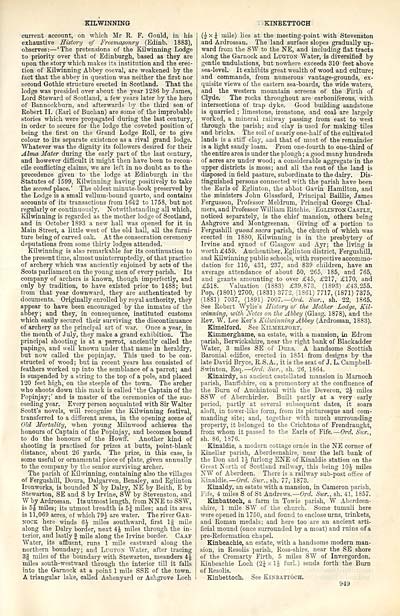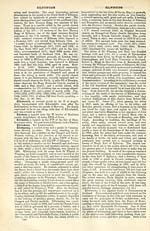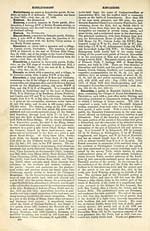Ordnance gazetteer of Scotland
(957) Page 949
Download files
Complete book:
Individual page:
Thumbnail gallery: Grid view | List view

KILWINNING
current account, on which Mr R. F. Gould, in his
exhaustive History of Freemasonry (Edinb. 1883),
observes: — 'The pretensions of the Kilwinning Lodge
to priority over that of Edinburgh, based as they are
upon the story which makes its institution and the erec-
tion of Kilwinning Abbey coeval, are weakened by the
fact that the abbey in question was neither the first nor
second Gothic structure erected in Scotland. That the
lodge was presided over about the year 1286 by James,
Lord Steward of Scotland, a few years later by the hero
of Bannockbnrn, and afterwards by the third son of
Robert II. (Earl of Buclian) are some of the improbable
stories which were propagated during the last century,
in order to secure for the lodge the coveted position of
being the first on the Grand Lodge Roll, or to give
colour to its separate existence as a rival grand lodge.
AVhatever was the dignity its followers desired for their
Alma Mater during the early part of the last century,
and however difficult it might then have been to recon-
cile conflicting claims, we are left in no doubt as to the
precedence given to the lodge at Edinburgh in the
Statutes of 1599, Kilwinning having positively to take
the second place.' The oldest minute-book preserved by
the Lodge is a small vellum-bound quarto, and contains
accounts of its transactions from 1642 to 1758, but not
regularly or continuously. Notwithstanding all which,
Kilwinning is regarded as the mother lodge of Scotland,
and in October 1893 a new hall was opened for it in
Main Street, a little west of the old hall, all the furni-
ture being of carved oak. At the consecration ceremony
deputations from some thirty lodges attended.
Kilwinning is also remarkable for its continuation to
the present time, almost uninterruptedly, of that practice
of archery which was anciently enjoined by acts of the
Scots parliament on the young men of every parish. Its
company of archers is known, though imperfectly, and
only by tradition, to have existed prior to 1488; but
from that year downward, they are authenticated by
documents. Originally enrolled by royal authority, they
appear to have been encouraged by the inmates of the
abbey; and they, in consequence, instituted customs
which easily secured their surviving the discontinuance
of archery as the principal art of war. Once a year, in
the month of July, they make a grand exhibition. The
principal shooting is at a parrot, anciently called the
papingo, and well known under that name in heraldry,
but now called the popinjay. This used to be con-
structed of wood; but in recent years has consisted of
feathers worked up into the semblance of a parrot; and
is suspended by a string to the top of a pole, and placed
120 feet high, on the steeple of the town. The archer
who shoots down this mark is called ' the Captain of the
Popinjay;' and is master of the ceremonies of the suc-
ceeding year. Every person acquainted with Sir Walter
Scott's novels, will recognise the Kilwinning festival,
transferred to a different arena, in the opening scene of
Old Mortality, when young Milnwood achieves the
honours of Captain of the Popinjay, and becomes bound
to do the honours of the Howff. Another kind of
shooting is practised for prizes at butts, point-blank
distance, about 26 yards. The prize, in this case, is
some useful or ornamental piece of plate, given annually
to the company by the senior surviving archer.
The parish of Kilwinning, containing also the villages
of Fergushill, Doura, Dalgarven, Bensley, and Eglinton
Ironworks, is bounded N by Dairy, NE by Beith, E by
Stewarton, SE and S by Irvine, SW by Stevenston, and
W by Ardrossan. Its utmost length, from NNE to SS W,
is 5J miles; its utmost breadth is 5j miles; and its area
is 11,069 acres, of which 79£ are water. The river Gar-
nock here winds 6 J miles southward, first lg mile
along the Dairy border, next 4J miles through the in-
terior, and lastly f mile along the Irvine border. Caaf
Water, its affluent, runs 1 mile eastward along the
northern boundary; and Lugton Water, after tracing
3| miles of the boundary with Stewarton, meanders 4J
miles south-westward through the interior till it falls
into the Garnock at a point 1 mile SSE of the town.
A triangular lake, called Ashenyard or Ashgrove Loch
KINBETTOCH
(^ x \ mile) lies at the meeting-point with Stevenston
and Ardrossan. The land surface slopes gradually up-
ward from the SW to the NE, and including flat tracts
along the Garnock and Lugton Water, is diversified by
gentle undulations, but nowhere exceeds 310 feet above
sea-level. It exhibits great wealth of wood and culture;
and commands, from numerous vantage-grounds, ex-
quisite views of the eastern sea-boards, the wide waters,
and the western mountain screens of the Firth of
Clyde. The rocks throughout are carboniferous, with
intersections of trap dyke. Good building sandstone
is quarried ; limestone, ironstone, and coal are largely
worked, a mineral railway passing from east to west
through the parish; and clay is used for making tiles
and bricks. The soil of nearly one-half of the cultivated
lands is a stiff clay, and that of most of the remainder
is a light sandy loam. From one-fourth to one-third of
the entire area is under the plough ; a good many hundreds
of acres are under wood; a considerable aggregate in the
upper districts is moss ; and all the rest of the land is
disposed in field pasture, subordinate to the dairy. Dis-
tinguished persons connected with the parish have been
the Earls of Eglinton, the abbot Gavin Hamilton, and
the ministers John Glassford, Principal Baillie, James
Fergusson, Professor Meldrum, Principal George Chal-
mers, and Professor William Ritchie. Eglinton Castle,
noticed separately, is the chief mansion, others being
Ashgrove and Montgreenan. Giving off a portion to
Fergushill quoad sacra parish, the church of which was
erected in 1880, Kilwinning is in the presbytery of
Irvine and synod of Glasgow and Ayr; the living is
worth £459. Auchentiber, Eglinton district, Fergushill,
and Kilwinning public schools, with respective accommo-
dation for 110, 431, 237, and 839 children, have an
average attendance of about 50, 265, 185, and 765,
and grants amounting to over £45, £217, £170, and
£518. Valuation (1883) £39,873, (1S93) £43,255.
Pop. (1801) 2700, (1831) 3772, (1S61) 7717, (1871) 7375,
(1881) 7037, (1891) 7007.— Ord. Sur., sh. 22, 1865.
See Robert Wylie's History of the Motlier Lodge, Kil-
vnnning, with Notes on the Abbey (Glasg. 1878), and the
Rev. W. Lee Ker's Kilwinning Abbey (Ardrossan, 1883).
Kimelford. See Kilmelfokt.
Kimmerghame, an estate, with a mansion, in Edrom
parish, Berwickshire, near the right bank of Blackadder
Water, 3 miles SE of Duns. A handsome Scottish
Baronial edifice, erected in 1851 from designs by the
late David Bryce, R.S.A., it is the seat of J. L. Campbell-
Swinton, Esq.— Ord. Sur., sh. 26, 1864.
Kinairdy, an ancient castellated mansion in Marnoch
parish, Banffshire, on a promontory at the confluence of
the Burn of Auchintoul with the Deveron, 2J miles
SSW of Aberchirder. Built partly at a very early
period, partly at several subsequent dates, it soars
aloft, in tower-like form, from its picturesque and com-
manding site; and, together with much surrounding
property, it belonged to the Crichtons of Frendraught,
from whom it passed to the Earls of Fife. — Ord. Sur.,
sh. S6, 1876.
Kinaldie, a modern cottage ornee in the NE corner of
Kinellar parish, Aberdeenshire, near the left bank of
the Don and 1J furlong ENE of Kinaldie station on the
Great North of Scotland railway, this being 10J miles
NW of Aberdeen. There is a railway sub-post office of
Kinaldie. — Ord. Sur., sh. 77, 1873.
Kinaldy, an estate with a mansion, in Cameron parish,
Fife, 4 miles S of St Andrews.— Ord. Sur., sh. 41, 1857.
Kinbattoch, a farm in Towie parish, W Aberdeen-
shire, 1 mile SW of the church. Some tumuli here
were opened in 1750, and found to enclose urns, trinkets,
and Roman medals; and here too are an ancient arti-
ficial mound (once surrounded by a moat) and ruins of a
pre-Reformation chapel.
Kinbeachie, an estate, with a handsome modern man-
sion, in Resolis parish, Ross-shire, near the SE shore
of the Cromarty Firth, 5 miles SW of Invergordon.
Kinbeachie Loch (2|xlJ furl.) sends forth the Burn
of Resolis.
Kinbettoch. See Kinbattoch.
949
current account, on which Mr R. F. Gould, in his
exhaustive History of Freemasonry (Edinb. 1883),
observes: — 'The pretensions of the Kilwinning Lodge
to priority over that of Edinburgh, based as they are
upon the story which makes its institution and the erec-
tion of Kilwinning Abbey coeval, are weakened by the
fact that the abbey in question was neither the first nor
second Gothic structure erected in Scotland. That the
lodge was presided over about the year 1286 by James,
Lord Steward of Scotland, a few years later by the hero
of Bannockbnrn, and afterwards by the third son of
Robert II. (Earl of Buclian) are some of the improbable
stories which were propagated during the last century,
in order to secure for the lodge the coveted position of
being the first on the Grand Lodge Roll, or to give
colour to its separate existence as a rival grand lodge.
AVhatever was the dignity its followers desired for their
Alma Mater during the early part of the last century,
and however difficult it might then have been to recon-
cile conflicting claims, we are left in no doubt as to the
precedence given to the lodge at Edinburgh in the
Statutes of 1599, Kilwinning having positively to take
the second place.' The oldest minute-book preserved by
the Lodge is a small vellum-bound quarto, and contains
accounts of its transactions from 1642 to 1758, but not
regularly or continuously. Notwithstanding all which,
Kilwinning is regarded as the mother lodge of Scotland,
and in October 1893 a new hall was opened for it in
Main Street, a little west of the old hall, all the furni-
ture being of carved oak. At the consecration ceremony
deputations from some thirty lodges attended.
Kilwinning is also remarkable for its continuation to
the present time, almost uninterruptedly, of that practice
of archery which was anciently enjoined by acts of the
Scots parliament on the young men of every parish. Its
company of archers is known, though imperfectly, and
only by tradition, to have existed prior to 1488; but
from that year downward, they are authenticated by
documents. Originally enrolled by royal authority, they
appear to have been encouraged by the inmates of the
abbey; and they, in consequence, instituted customs
which easily secured their surviving the discontinuance
of archery as the principal art of war. Once a year, in
the month of July, they make a grand exhibition. The
principal shooting is at a parrot, anciently called the
papingo, and well known under that name in heraldry,
but now called the popinjay. This used to be con-
structed of wood; but in recent years has consisted of
feathers worked up into the semblance of a parrot; and
is suspended by a string to the top of a pole, and placed
120 feet high, on the steeple of the town. The archer
who shoots down this mark is called ' the Captain of the
Popinjay;' and is master of the ceremonies of the suc-
ceeding year. Every person acquainted with Sir Walter
Scott's novels, will recognise the Kilwinning festival,
transferred to a different arena, in the opening scene of
Old Mortality, when young Milnwood achieves the
honours of Captain of the Popinjay, and becomes bound
to do the honours of the Howff. Another kind of
shooting is practised for prizes at butts, point-blank
distance, about 26 yards. The prize, in this case, is
some useful or ornamental piece of plate, given annually
to the company by the senior surviving archer.
The parish of Kilwinning, containing also the villages
of Fergushill, Doura, Dalgarven, Bensley, and Eglinton
Ironworks, is bounded N by Dairy, NE by Beith, E by
Stewarton, SE and S by Irvine, SW by Stevenston, and
W by Ardrossan. Its utmost length, from NNE to SS W,
is 5J miles; its utmost breadth is 5j miles; and its area
is 11,069 acres, of which 79£ are water. The river Gar-
nock here winds 6 J miles southward, first lg mile
along the Dairy border, next 4J miles through the in-
terior, and lastly f mile along the Irvine border. Caaf
Water, its affluent, runs 1 mile eastward along the
northern boundary; and Lugton Water, after tracing
3| miles of the boundary with Stewarton, meanders 4J
miles south-westward through the interior till it falls
into the Garnock at a point 1 mile SSE of the town.
A triangular lake, called Ashenyard or Ashgrove Loch
KINBETTOCH
(^ x \ mile) lies at the meeting-point with Stevenston
and Ardrossan. The land surface slopes gradually up-
ward from the SW to the NE, and including flat tracts
along the Garnock and Lugton Water, is diversified by
gentle undulations, but nowhere exceeds 310 feet above
sea-level. It exhibits great wealth of wood and culture;
and commands, from numerous vantage-grounds, ex-
quisite views of the eastern sea-boards, the wide waters,
and the western mountain screens of the Firth of
Clyde. The rocks throughout are carboniferous, with
intersections of trap dyke. Good building sandstone
is quarried ; limestone, ironstone, and coal are largely
worked, a mineral railway passing from east to west
through the parish; and clay is used for making tiles
and bricks. The soil of nearly one-half of the cultivated
lands is a stiff clay, and that of most of the remainder
is a light sandy loam. From one-fourth to one-third of
the entire area is under the plough ; a good many hundreds
of acres are under wood; a considerable aggregate in the
upper districts is moss ; and all the rest of the land is
disposed in field pasture, subordinate to the dairy. Dis-
tinguished persons connected with the parish have been
the Earls of Eglinton, the abbot Gavin Hamilton, and
the ministers John Glassford, Principal Baillie, James
Fergusson, Professor Meldrum, Principal George Chal-
mers, and Professor William Ritchie. Eglinton Castle,
noticed separately, is the chief mansion, others being
Ashgrove and Montgreenan. Giving off a portion to
Fergushill quoad sacra parish, the church of which was
erected in 1880, Kilwinning is in the presbytery of
Irvine and synod of Glasgow and Ayr; the living is
worth £459. Auchentiber, Eglinton district, Fergushill,
and Kilwinning public schools, with respective accommo-
dation for 110, 431, 237, and 839 children, have an
average attendance of about 50, 265, 185, and 765,
and grants amounting to over £45, £217, £170, and
£518. Valuation (1883) £39,873, (1S93) £43,255.
Pop. (1801) 2700, (1831) 3772, (1S61) 7717, (1871) 7375,
(1881) 7037, (1891) 7007.— Ord. Sur., sh. 22, 1865.
See Robert Wylie's History of the Motlier Lodge, Kil-
vnnning, with Notes on the Abbey (Glasg. 1878), and the
Rev. W. Lee Ker's Kilwinning Abbey (Ardrossan, 1883).
Kimelford. See Kilmelfokt.
Kimmerghame, an estate, with a mansion, in Edrom
parish, Berwickshire, near the right bank of Blackadder
Water, 3 miles SE of Duns. A handsome Scottish
Baronial edifice, erected in 1851 from designs by the
late David Bryce, R.S.A., it is the seat of J. L. Campbell-
Swinton, Esq.— Ord. Sur., sh. 26, 1864.
Kinairdy, an ancient castellated mansion in Marnoch
parish, Banffshire, on a promontory at the confluence of
the Burn of Auchintoul with the Deveron, 2J miles
SSW of Aberchirder. Built partly at a very early
period, partly at several subsequent dates, it soars
aloft, in tower-like form, from its picturesque and com-
manding site; and, together with much surrounding
property, it belonged to the Crichtons of Frendraught,
from whom it passed to the Earls of Fife. — Ord. Sur.,
sh. S6, 1876.
Kinaldie, a modern cottage ornee in the NE corner of
Kinellar parish, Aberdeenshire, near the left bank of
the Don and 1J furlong ENE of Kinaldie station on the
Great North of Scotland railway, this being 10J miles
NW of Aberdeen. There is a railway sub-post office of
Kinaldie. — Ord. Sur., sh. 77, 1873.
Kinaldy, an estate with a mansion, in Cameron parish,
Fife, 4 miles S of St Andrews.— Ord. Sur., sh. 41, 1857.
Kinbattoch, a farm in Towie parish, W Aberdeen-
shire, 1 mile SW of the church. Some tumuli here
were opened in 1750, and found to enclose urns, trinkets,
and Roman medals; and here too are an ancient arti-
ficial mound (once surrounded by a moat) and ruins of a
pre-Reformation chapel.
Kinbeachie, an estate, with a handsome modern man-
sion, in Resolis parish, Ross-shire, near the SE shore
of the Cromarty Firth, 5 miles SW of Invergordon.
Kinbeachie Loch (2|xlJ furl.) sends forth the Burn
of Resolis.
Kinbettoch. See Kinbattoch.
949
Set display mode to: Large image | Transcription
Images and transcriptions on this page, including medium image downloads, may be used under the Creative Commons Attribution 4.0 International Licence unless otherwise stated. ![]()
| Gazetteers of Scotland, 1803-1901 > Ordnance gazetteer of Scotland > (957) Page 949 |
|---|
| Permanent URL | https://digital.nls.uk/97404730 |
|---|

